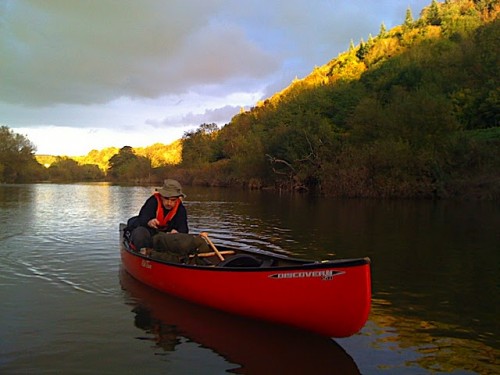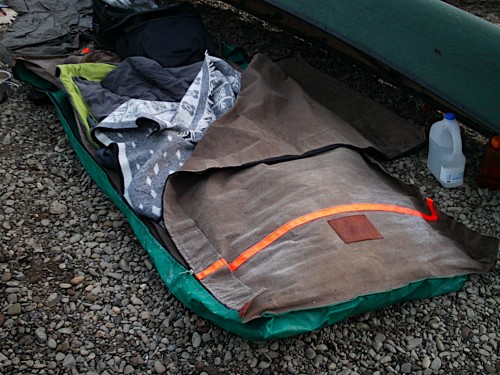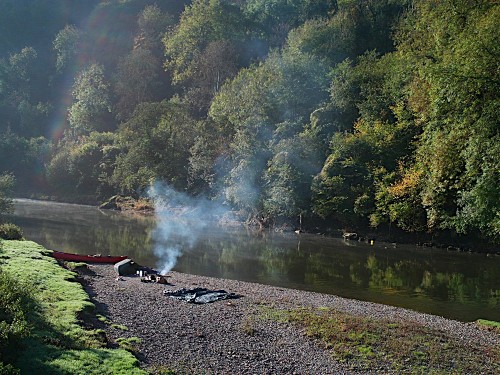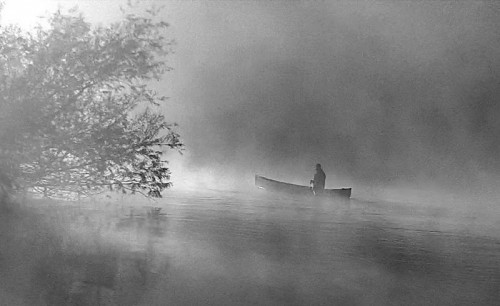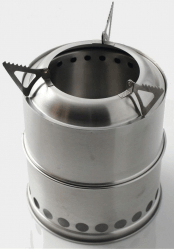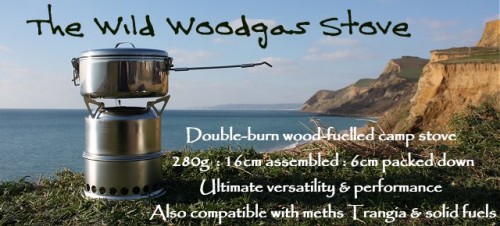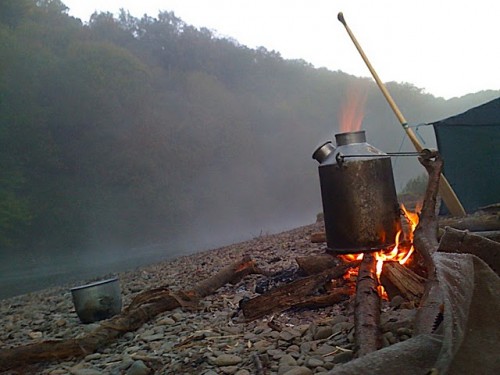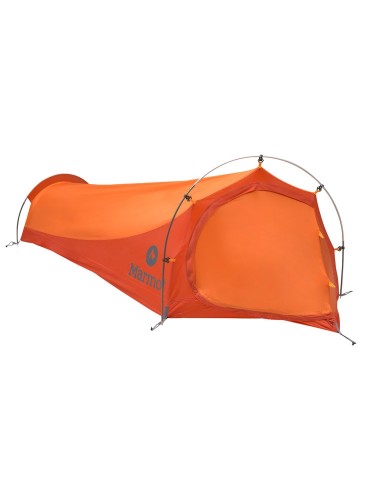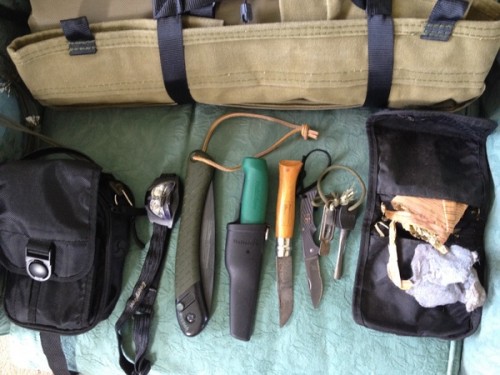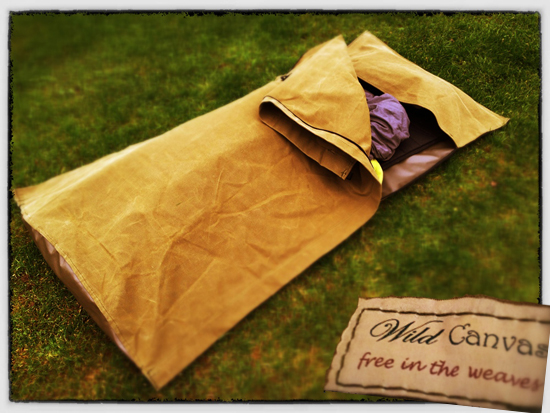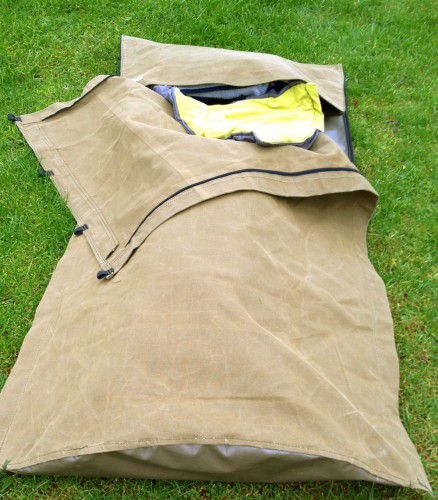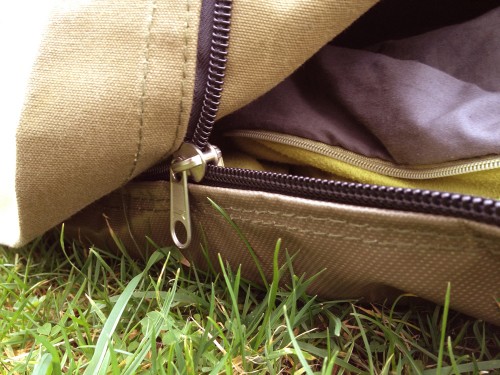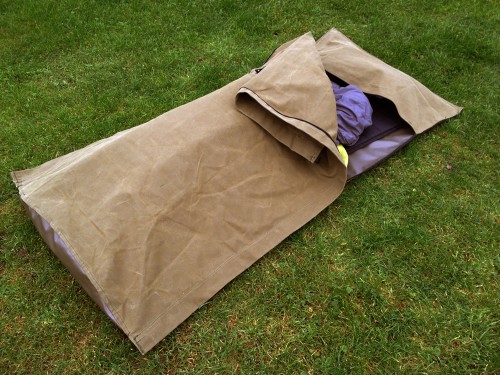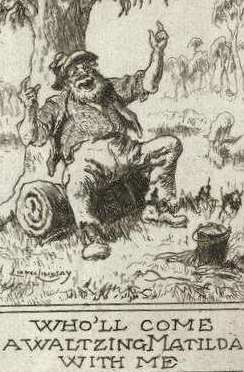The most detailed 19th Century Australian description of the swag is found in Henry Lawson’s The Romance of the Swag:
Source: http://catalogue.nla.gov.au/Record/1200626
The Australian swag fashion is the easiest way in the world of carrying a load. I ought to know something about carrying loads: I’ve carried babies, which are the heaviest and most awkward and heartbreaking loads in this world for a boy or man to carry, I fancy. God remember mothers who slave about the housework (and do sometimes a man’s work in addition in the bush) with a heavy, squalling kid on one arm! I’ve humped logs on the selection, “burning-off,” with loads of fencing-posts and rails and palings out of steep, rugged gullies (and was happier then, perhaps); I’ve carried a shovel, crowbar, heavy “rammer,” a dozen insulators on an average (strung round my shoulders with raw flax)-to say nothing of soldiering kit, tucker-bag, billy and climbing spurs–all day on a telegraph line in rough country in New Zealand, and in places where a man had to manage his load with one hand and help himself climb with the other; and I’ve helped hump and drag telegraph-poles up cliffs and sidings where the horses couldn’t go. I’ve carried a portmanteau on the hot dusty roads in green old jackaroo days. Ask any actor who’s been stranded and had to count railway sleepers from one town to another! he’ll tell you what sort of an awkward load a portmanteau is, especially if there’s a broken-hearted man underneath it. I’ve tried knapsack fashion–one of the least healthy and most likely to give a man sores; I’ve carried my belongings in a three-bushel sack slung over my shoulder–blankets, tucker, spare boots and poetry all lumped together. I tried carrying a load on my head, and got a crick in my neck and spine for days. I’ve carried a load on my mind that should have been shared by editors and publishers. I’ve helped hump luggage and furniture up to, and down from, a top flat in London. And I’ve carried swag for months out back in Australia–and it was life, in spite of its “squalidness” and meanness and wretchedness and hardship, and in spite of the fact that the world would have regarded us as “tramps”–and a free life amongst men from all the world!
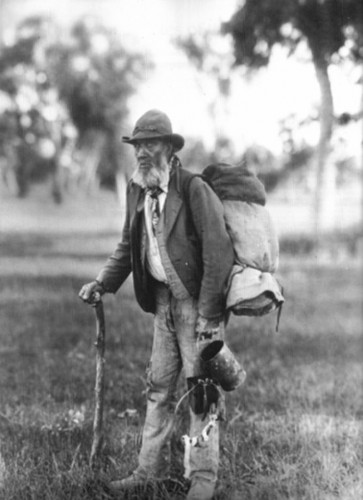
By Unknown photographer, via Wikimedia Commons http://commons.wikimedia.org/wiki/File:Elderly_swagman.jpg
The Australian swag was born of Australia and no other land–of the Great Lone Land of magnificent distances and bright heat; the land of self-reliance, and never-give-in, and help-your-mate. The grave of many of the world’s tragedies and comedies–royal and otherwise. The land where a man out of employment might shoulder his swag in Adelaide and take the track, and years later walk into a hut on the Gulf, or never be heard of any more, or a body be found in the bush and buried by the mounted police, or never found and never buried–what does it matter?
…
The swag is usually composed of a tent “fly” or strip of calico (a cover for the swag and a shelter in bad weather–in New Zealand it is oilcloth or waterproof twill), a couple of blankets, blue by custom and preference, as that colour shows the dirt less than any other (hence the name “bluey” for swag), and the core is composed of spare clothing and small personal effects. To make or “roll up” your swag: lay the fly or strip of calico on the ground, blueys on top of it;
…
To the top strap fasten the string of the nose-bag, a calico bag about the size of a pillowslip, containing the tea, sugar and flour bags, bread, meat, baking-powder and salt, and brought, when the swag is carried from the left shoulder, over the right on to the chest, and so balancing the swag behind. But a swagman can throw a heavy swag in a nearly vertical position against his spine, slung from one shoulder only and without any balance, and carry it as easily as you might wear your overcoat. Some bushmen arrange their belongings so neatly and conveniently, with swag straps in a sort of harness, that they can roll up the swag in about a minute, and unbuckle it and throw it out as easily as a roll of wall-paper, and there’s the bed ready on the ground with the wardrobe for a pillow. The swag is always used for a seat on the track; it is a soft seat, so trousers last a long time. And, the dust being mostly soft and silky on the long tracks out back, boots last marvellously. Fifteen miles a day is the average with the swag, but you must travel according to the water: if the next bore or tank is five miles on, and the next twenty beyond, you camp at the five-mile water to-night and do the twenty next day. But if it’s thirty miles you have to do it. Travelling with the swag in Australia is variously and picturesquely described as “humping bluey,” “walking Matilda,” “humping Matilda,” “humping your drum,” “being on the wallaby,” “jabbing trotters,” and “tea and sugar burglaring,” but most travelling shearers now call themselves trav’lers, and say simply “on the track,” or “carrying swag.”
And there you have the Australian swag. Men from all the world have carried it–lords and low-class Chinamen, saints and world martyrs, and felons, thieves, and murderers, educated gentlemen and boors who couldn’t sign their mark, gentlemen who fought for Poland and convicts who fought the world, women, and more than one woman disguised as a man. The Australian swag has held in its core letters and papers in all languages, the honour of great houses, and more than one national secret, papers that would send well-known and highly-respected men to jail, and proofs of the innocence of men going mad in prisons, life tragedies and comedies, fortunes and papers that secured titles and fortunes, and the last pence of lost fortunes, life secrets, portraits of mothers and dead loves, pictures of fair women, heart-breaking old letters written long ago by vanished hands, and the pencilled manuscript of more than one book which will be famous yet.
The weight of the swag varies from the light rouseabout’s swag, containing one blanket and a clean shirt, to the “royal Alfred,” with tent and all complete, and weighing part of a ton. Some old sundowners have a mania for gathering, from selectors’ and shearers’ huts, and dust-heaps, heart-breaking loads of rubbish which can never be of any possible use to them or anyone else. Here is an inventory of the contents of the swag of an old tramp who was found dead on the track, lying on his face on the sand, with his swag on top of him, and his arms stretched straight out as if he were embracing the mother earth, or had made, with his last movement, the sign of the cross to the blazing heavens:
Rotten old tent in rags. Filthy blue blanket, patched with squares of red and calico. Half of “white blanket” nearly black now, patched with pieces of various material and sewn to half of red blanket. Three-bushel sack slit open. Pieces of sacking. Part of a woman’s skirt. Two rotten old pairs of moleskin trousers. One leg of a pair of trousers. Back of a shirt. Half a waistcoat. Two tweed coats, green, old and rotting, and patched with calico. Blanket, etc. Large bundle of assorted rags for patches, all rotten. Leaky billy-can, containing fishing-line, papers, suet, needles and cotton, etc. Jam-tin, medicine bottles, corks on strings, to hang to his hat to keep the flies off (a sign of madness in the bush, for the corks would madden a sane man sooner than the flies could). Three boots of different sizes, all belonging to the right foot, and a left slipper. Coffee-pot, without handle or spout, and quart-pot full of rubbish–broken knives and forks, with the handles burnt off, spoons, etc., picked up on rubbish-heaps; and many rusty nails, to be used as buttons, I suppose.
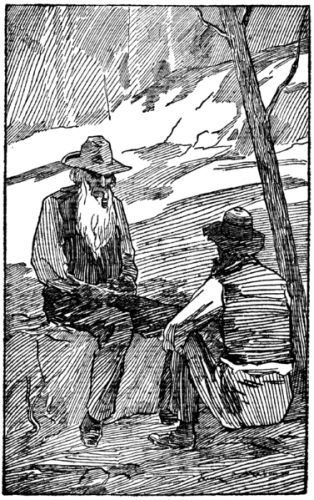
They would talk some old lead, while the billy boils...
Broken saw blade, hammer, broken crockery, old pannikins, small rusty frying-pan without a handle, children’s old shoes, many bits of old bootleather and greenhide, part of yellowback novel, mutilated English dictionary, grammar and arithmetic book, a ready reckoner, a cookery book, a bulgy anglo-foreign dictionary, part of a Shakespeare, book in French and book in German, and a book on etiquette and courtship. A heavy pair of blucher boots, with uppers parched and cracked, and soles so patched (patch over patch) with leather, boot protectors, hoop iron and hobnails that they were about two inches thick, and the boots weighed over five pounds. (If you don’t believe me go into the Melbourne Museum, where, in a glass case in a place of honour, you will see a similar, perhaps the same, pair of bluchers labelled “An example of colonial industry.”) And in the core of the swag was a sugar-bag tied tightly with a whip-lash, and containing another old skirt, rolled very tight and fastened with many turns of a length of clothes-line, which last, I suppose, he carried to hang himself with if he felt that way. The skirt was rolled round a small packet of old portraits and almost indecipherable letters–one from a woman who had evidently been a sensible woman and a widow, and who stated in the letter that she did not intend to get married again as she had enough to do already, slavin’ her finger-nails off to keep a family, without having a second husband to keep. And her answer was “final for good and all,” and it wasn’t no use comin’ “bungfoodlin'” round her again. If he did she’d set Satan on to him. “Satan” was a dog, I suppose.
The letter was addressed to “Dear Bill,” as were others. There were no envelopes. The letters were addressed from no place in particular, so there weren’t any means of identifying the dead man. The police buried him under a gum, and a young trooper cut on the tree the words:
SACRED TO THE MEMORY OF BILL WHO DIED.
Who Was Henry Lawson?
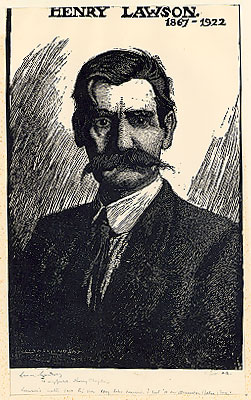
Print of Henry Lawson (1867–1922) Australian writer & poet who documented 19th Century life in the outback
Henry Lawson (17 June 1867 – 2 September 1922) was an Australian writer and poet. Along with his contemporary Banjo Paterson (who penned the famous “Waltzing Matilda”), Lawson is among the best-known Australian poets and fiction writers of the colonial period, and is often called Australia’s “greatest writer”. Henry Lawson was born in a town on the Grenfell goldfields of New South Wales. His father was Niels Herzberg Larsen, a Norwegian-born miner who went to sea at 21 and arrived in Melbourne in 1855 to join the gold rush, along with partner William Henry John Slee.[2] Lawson’s parents met at the goldfields of Pipeclay (now Eurunderee New South Wales), Niels and Louisa Albury (1848–1920) married on 7 July 1866; he was 32 and she, 18.
Henry Lawson, Collected Verse, Volume one: 1895 – 1900, (Ed.) Colin Roderick, Angus & Robertson (Australia, 1967).
On The Wallaby
By Henry Lawson.
Now the tent poles are rotting, the camp fires are dead,
And the possums may gambol in trees overhead;
I am humping my bluey far out on the land,
And the prints of my bluchers sink deep in the sand:
I am out on the wallaby humping my drum,
And I came by the tracks where the sundowners come.
It is nor’-west and west o’er the ranges and far
To the plains where the cattle and sheep stations are,
With the sky for my roof and the grass for my bunk,
And a calico bag for my damper and junk;
And scarcely a comrade my memory reveals,
Save the spiritless dingo in tow of my heels. *
But I think of the honest old light of my home
When the stars hang in clusters like lamps from the dome,
And I think of the hearth where the dark shadows fall,
When my camp fire is built on the widest of all;
But I’m following Fate, for I know she knows best,
I follow, she leads, and it’s nor’-west by west.
When my tent is all torn and my blankets are damp,
And the rising flood waters flow fast by the camp,
When the cold water rises in jets from the floor,
I lie in my bunk and I list to the roar,
And I think how to-morrow my footsteps will lag
When I tramp ‘neath the weight of a rain-sodden swag.
Though the way of the swagman is mostly up-hill,
There are joys to be found on the wallaby still.
When the day has gone by with its tramp or its toil,
And your camp fire you light, and your billy you boil,
There is comfort and peace in the bowl of your clay
Or the yarn of a mate who is tramping that way.
But beware of the town-there is poison for years
In the pleasure you find in the depths of long beers;
For the bushman gets bushed in the streets of a town,
Where he loses his friends when his cheque is knocked down;
He is right till his pockets are empty, and then –
He can hump his old bluey up country again.
[Brisbane, July 1891 (revised August 1891)
